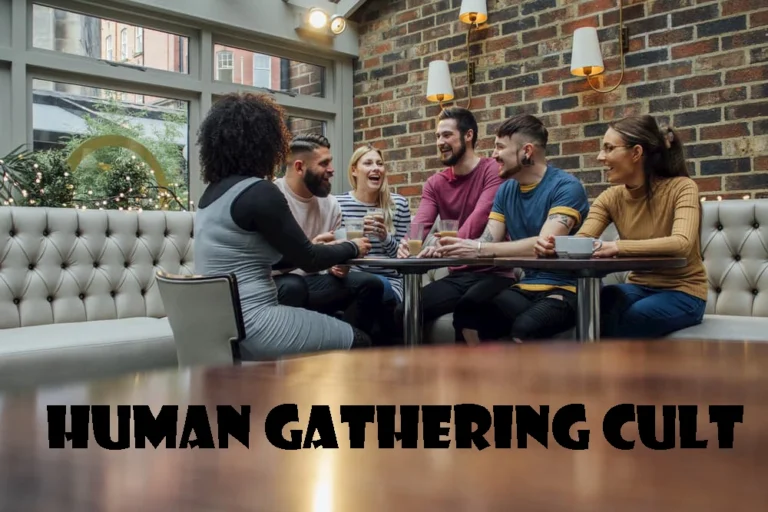The Human Gathering Cult, a phenomenon that has garnered attention and concern in recent years, represents a complex and enigmatic aspect of society. This cult, characterized by its secretive practices and devotion to a central figure or ideology, has sparked curiosity and controversy alike. As its name suggests, the Human Gathering Cult revolves around the gathering of individuals who share a common belief system or set of principles.
While the specifics of its beliefs and rituals may vary widely, the underlying dynamics of control, manipulation, and devotion remain consistent across different iterations of the cult. In this introduction, we will delve into the origins, practices, and impact of the Human Gathering Cult, shedding light on this intriguing yet often misunderstood phenomenon.
Human Gathering Cult: Origins and Beliefs
The origins of the Human Gathering Cult traced back to a complex interplay of social, psychological, and historical factors. While specific details may vary, many cults emerge from charismatic leaders or influential figures who espouse unconventional beliefs or ideologies. These leaders often attract followers through persuasive rhetoric, promising solutions to existential or societal concerns. In the case of the Human Gathering Cult, the origins may be rooted in a charismatic leader’s interpretation of spiritual, philosophical, or even apocalyptic beliefs.
These beliefs may center around themes of enlightenment, salvation, or the attainment of higher consciousness. Followers are drawn to the cult’s teachings, seeking meaning, community, or a sense of purpose in their lives. Over time, these beliefs may evolve and become increasingly entrenched within the cult’s culture, shaping its practices, rituals, and worldview. Understanding the origins and beliefs of the Human Gathering Cult is essential for comprehending its influence and impact on individuals and society as a whole.
Tips for Dealing with the Human Gathering Cult
Educate Yourself: Learn about the tactics and characteristics commonly associated with cults, including the Human Gathering Cult. Understanding how cults operate can help you recognize warning signs and protect yourself and others from potential manipulation.
Trust Your Instincts: If something feels off or too good to be true, trust your instincts. Cults often use persuasive tactics to lure in new members, so it’s important to listen to your gut feelings and proceed with caution if you have doubts.
Maintain Healthy Boundaries: Cults may attempt to isolate individuals from their friends, family, and support networks. Prioritize maintaining healthy boundaries and relationships outside of the cult to prevent undue influence and maintain a sense of perspective.
Seek Support: If you or someone you know is involved in a cult like the Human Gathering Cult, seek support from trusted friends, family members, or professionals. Cult involvement can be emotionally and psychologically draining, so having a support system in place is crucial.
Research Before Joining: Before becoming involved with any group or organization, research its background, leadership, and beliefs. Look for credible sources of information and be wary of groups that exhibit secretive or controlling behavior.
Practice Critical Thinking: Cults often rely on manipulation and thought control to maintain their influence over members. Practice critical thinking skills and question information presented to you, especially if it seems too extreme or contradictory.
Encourage Open Dialogue: If you suspect that someone you care about is involved in a cult, approach the situation with compassion and encourage open dialogue. Avoid judgmental or confrontational language and offer your support in a non-judgmental manner.
Report Suspicious Activity: If you encounter or witness suspicious or concerning behavior related to the Human Gathering Cult, consider reporting it to the appropriate authorities or organizations. Your report could help prevent further harm to individuals and communities.
Human Gathering Cult: Practices and Rituals
The Human Gathering Cult is characterized by a myriad of practices and rituals that serve to reinforce its ideology and strengthen the bonds among its members. These rituals often involve ceremonial gatherings, meditation sessions, or communal activities designed to foster a sense of unity and devotion among followers. Additionally, cult leaders may prescribe specific behavioral norms or codes of conduct that members are expected to adhere to, further solidifying their commitment to the group. Rituals may also include symbolic gestures or acts of worship aimed at venerating the cult’s central figure or belief system. By engaging in these practices, followers reaffirm their allegiance to the cult and deepen their involvement in its activities.
Human Gathering Cult: Recruitment and Indoctrination
Recruitment and indoctrination play pivotal roles in the expansion and perpetuation of the Human Gathering Cult. Cult leaders employ various techniques to attract new members and instill their beliefs within them. These tactics may include persuasive rhetoric, charismatic presentations, or promises of spiritual enlightenment or salvation. Recruits are often targeted during vulnerable periods in their lives, such as times of personal crisis or existential uncertainty.
Once recruited, individuals undergo a process of indoctrination wherein they are gradually introduced to the cult’s ideology and encouraged to adopt its worldview. This indoctrination may involve isolation from external influences, manipulation of information, and reinforcement of cultic beliefs through group dynamics and peer pressure. Ultimately, recruitment and indoctrination are essential mechanisms through which the Human Gathering Cult maintains its influence and expands its membership base.
Human Gathering Cult: Structure and Leadership
The Human Gathering Cult operates within a structured hierarchy that is typically centralized around its charismatic leader or leaders. At the top of the hierarchy is the cult’s leader, who wields significant influence and control over its members. Beneath the leader, there may be layers of leadership comprising trusted advisors, inner circle members, and hierarchical ranks. The structure of the cult may also include specialized roles or responsibilities assigned to members based on their skills, talents, or level of devotion.
This hierarchical structure facilitates the dissemination of the cult’s ideology, the implementation of its practices, and the enforcement of its rules and norms. Additionally, the leader or leadership cadre may exercise authoritarian control over the group, dictating its direction, decision-making processes, and interactions with the outside world.
Human Gathering Cult: Impact on Members
The Human Gathering Cult can have profound and far-reaching impacts on its members, both psychologically and socially. Many members experience a sense of belonging and identity within the cult, finding validation, purpose, and community among like-minded individuals. However, the cult’s influence may also result in detrimental effects on members’ well-being and autonomy. Cult members may become psychologically dependent on the group and its leaders, relinquishing their critical thinking skills and personal autonomy in favor of unquestioning obedience.
Additionally, the cult’s strict adherence to its ideology and practices may lead to isolation from friends, family, and mainstream society, further deepening members’ dependency on the group. In extreme cases, cult involvement can result in psychological manipulation, emotional abuse, and exploitation of members for the benefit of the leadership. Understanding the impact of the Human Gathering Cult on its members is crucial for recognizing the potential harms associated with involvement in such groups and for providing support and intervention to those affected.
Human Gathering Cult: Controversies and Criticisms
The Human Gathering Cult has been the subject of numerous controversies and criticisms due to its secretive nature, manipulative tactics, and potential for harm to its members and society at large. Critics argue that cults like the Human Gathering Cult exploit vulnerable individuals, coercing them into relinquishing their autonomy and blindly following the dictates of charismatic leaders.
Controversies may arise from reports of psychological manipulation, emotional abuse, financial exploitation, or even allegations of criminal activity within the cult. Additionally, concerns may be raised about the cult’s impact on members’ mental health, relationships, and overall well-being. Furthermore, the cult’s isolationist tendencies and aversion to external scrutiny often fuel suspicions and criticisms from the public and authorities alike.
Human Gathering Cult: Efforts for Prevention and Intervention
Efforts to prevent and intervene in the activities of the Human Gathering Cult are multifaceted and may involve various stakeholders, including government agencies, law enforcement, mental health professionals, and concerned individuals. Prevention efforts may focus on raising public awareness about the tactics and dangers of cults, providing education and support to vulnerable populations, and promoting critical thinking skills and resilience against manipulation.
Intervention strategies may include legal measures to investigate and prosecute cult leaders for criminal behavior, providing counseling and support services to cult members seeking to leave the group, and facilitating family interventions to reconnect with loved ones who have become involved in cults. Collaborative efforts between government agencies, advocacy groups, and mental health professionals are essential for effectively addressing the challenges posed by the Human Gathering Cult and similar groups.
Human Gathering Cult: Legal and Ethical Considerations
The Human Gathering Cult presents a myriad of legal and ethical considerations that demand careful scrutiny and action from various stakeholders. From a legal standpoint, cult activities may intersect with a range of statutes and regulations pertaining to fraud, coercion, abuse, and human rights violations. Law enforcement agencies and legal authorities may employ investigative techniques to gather evidence of criminal behavior within the cult, such as financial fraud, manipulation, or exploitation.
Conclusion:
In conclusion, the Human Gathering Cult represents a complex and multifaceted phenomenon that raises significant legal, ethical, and societal concerns. As evidenced by its secretive practices, manipulative tactics, and potential for harm to its members, the cult poses a challenge to individuals, communities, and authorities alike. Efforts to address the Human Gathering Cult must navigate a delicate balance between upholding the principles of justice, safeguarding individuals’ rights and autonomy, and protecting vulnerable individuals from exploitation and harm.
Collaboration between legal authorities, mental health professionals, advocacy groups, and community stakeholders is essential for effectively addressing the challenges posed by cult involvement and promoting ethical responses to ensure the safety and well-being of all individuals affected by the cult. By remaining vigilant, informed, and united in our efforts, we can work towards mitigating the risks posed by the Human Gathering Cult and safeguarding the rights and dignity of its members and society as a whole.









